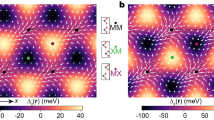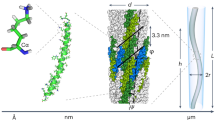Abstract
THE Maier–Saupe theory of nematic liquid crystals is founded on a molecular field treatment of long-range contributions to the intermolecular potential and ignores the important shortrange forces. Nonetheless this theory is particularly successful in predicting the orientational properties of real nematics. Here we propose a model which accounts both for the success of the Maier–Saupe theory and the failure of theories based exclusively on short-range forces.
This is a preview of subscription content, access via your institution
Access options
Subscribe to this journal
Receive 51 print issues and online access
$199.00 per year
only $3.90 per issue
Buy this article
- Purchase on Springer Link
- Instant access to full article PDF
Prices may be subject to local taxes which are calculated during checkout
Similar content being viewed by others
References
Maier, W. & Saupe, A. Z. Naturforsch. 13 a, 564–570 (1959); 14 a, 882–900 (1959); 15 a, 287–292 (1960).
Saupe, A. (ed.) Angew. Chem. int. 7, 97–118 (1968).
Faber, T. E. & Luckhurst, G. R. A. Rep., A72, 31–65 (1975).
Humpries, R. L., James, P. G. & Luckhurst, G. R. J. Chem. Soc. Faraday Trans. II 68, 1031–1044 (1972).
Luckhurst, G. R., Zannoni, C., Nordio, P. L. & Segre, U. Molec. Phys. 30, 1345–1358 (1975).
Sheng, P. & Wojtowicz, P. J. Phys. Rev. A14, 1883–1894 (1976).
Kaplan, J. L. & Drauglis, E. Chem. Phys. Lett. 9, 645 (1971).
Wulf, A. J. chem. Phys. 64, 104–109 (1976).
Dunmur, D. A. Molec. Phys. 23, 109–115 (1972).
Andersen, H. C., Chandler, D. & Weeks, J. D. Adv. chem. Phys. 34, 105–156 (1976).
Onsager, L. Ann. N.Y. Acad. Sci. 51, 627–659 (1949).
Alben, R. Molec. Cryst. Liq. Cryst. 13, 193–203 (1971).
Cotter, M. A. Phys. Rev. A10, 625–636 (1974).
Kushick, J. & Berne, B. J. J. chem Phys., 64, 1362–1367 (1976).
McColl, J. R. & Shih, C. S. Phys. Rev. Lett. 29, 85–87 (1972).
Humphries, R. L. & Luckhurst, G. R. Chem. Phys. Lett. 17, 514–515 (1972).
Zannoni, C. thesis, Univ. Southampton (1975).
Leadbetter, A. J., Richardson, R. M. & Colling, N. J. Phys. (Paris) 36, Cl 37–43 (1975).
Niimura, N. Molec. Crystal. Liq. Crystal. 31, 123–130 (1975).
Evans, M., Davies, M. & Larkin, I. J. Chem. Soc., Faraday Trans. II 69, 1011–1022 (1973).
Author information
Authors and Affiliations
Rights and permissions
About this article
Cite this article
LUCKHURST, G., ZANNONI, C. Why is the Maier–Saupe theory of nematic liquid crystals so successful?. Nature 267, 412–414 (1977). https://doi.org/10.1038/267412b0
Received:
Accepted:
Issue Date:
DOI: https://doi.org/10.1038/267412b0
This article is cited by
-
Ericksen’s Secret Influence
Journal of Elasticity (2022)
-
Orientation Distribution of Molecules: Characterization and Experimental Determination by Means of Magnetic Resonance
Applied Magnetic Resonance (2020)
Comments
By submitting a comment you agree to abide by our Terms and Community Guidelines. If you find something abusive or that does not comply with our terms or guidelines please flag it as inappropriate.



